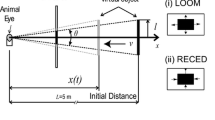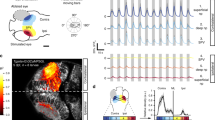Abstract
Stomatopods locate prey, within a short range of distances, with one eye and strike it within a few milliseconds. We developed a model based on the complex input patterns of the eye transferred to a matrix of neural integrators called T2 and T3 fibers. In the integrators graded potentials are summed and generate spikes if the sum reaches threshold. Histograms of instantaneous frequencies were simulated on a PC for the T2 and for the T3 fibers for motion of a luminous point parallel to the T2 fibers and for approach of the point towards the eye. Position, size, speed of motion and distance of the target could be extracted from the frequency-pattern-coded output of the integrators in our model. A critical region in front of the center of the eye could be defined. This region is elliptical in shape and adapted to the size of the animal (respectively to the size of its raptorial appendages). We assume that prey is hit when it is in the critical zone. Histological and electrophysiological results seem to confirm our model.
Similar content being viewed by others
References
Abbott BC, Manning R, Schiff H (1984) An attempt to correlate pseudopupil sizes and shapes with ambient light conditions and behaviour patterns. Comp Biochem Physiol 78A:419–426
Burrows M, Hoyle G (1972) Neuromuscular physiology of the strike mechanism of the mantis shrimp, Hemisquilla. Exp Zool 179:379–394
Goetz KG (1965) Die optischen Ubertragungseigenschaften der Komplexaugen von Drosophila. Kybernetik 2:215–221
Horridge GA, Duelli P (1979) Anatomy of the regional differences in the eye of the mantis Ciulfina. J Exp Biol 80:165–190
Ohlberg RM (1986) Identified target-selective visual interneurons descending from the dragonfly brain. J Comp Physiol 159:827–840
Raymond SA (1979) Effects of nerve impulses on the threshold of frog sciatic nerve fibers. J Physiol 290:273–303
Schaller F (1953) Verhaltens- und sinnesphysiologische Beobachtungen an Squilla mantis. Z Tierpsychol 10:1–12
Schiff H (1976) The frequency pattern in the nervous hierarchy of a compound eye. Monitore Zool Ital 10:349–379
Schiff H (1987) Optical and neural pooling in crustacean vision. Comp Biochem Physiol 88A:1–13
Schiff H (1989) Visual patterns correlated to behavior and habitat of the mantis shrimp, Gonodactylus. Comp Biochem Physiol 94A:75–87
Schiff H, Abbott BC (1989) Stomatopod vision. In: Ferrero EA (ed) Biology of stomatopods. Selected Symposia and Monographs U. Z. I. 3. Mucchi, Modena, pp 11–38
Schiff H, Candone P (1986) Superposition and scattering of visual fields in a compound, double eye. II. Stimulation sequences for different distances in a stomatopod from a bright habitat. Comp Biochem Physiol 83A:433–444
Schiff H, Abbott BC, Manning RB (1985) Possible monocular range-finding mechanisms in stomatopods from different environmental light conditions. Comp Biochem Physiol 80A:271–280
Schiff H, Abbott BC, Manning RB (1986a) Optics, range-finding and neuroanatomy of the eye of a mantis shrimp, Squilla mantis (Linnaeus) (Crustacea: stomatopoda: Squillidae). Smithson Contrib Zool 440:1–32
Schiff H, D'Isep F, Candone P (1986b) Superposition and scattering of visual fields in a compound, double eye. I. Stimulation sequences for different distances in a stomatopod from a dim habitat. Comp Biochem Physiol 83A:445–455
Schiff H, Manning RB, Abbott BC (1986c) Structure and optics of ommatidia from eyes of stomatopod crustaceans from different luminous habitats. Biol Bull 170:461–480
Schiff H, Castelletti G, DiStefano G, Iacino L (1989a) A model for the dynamic properties of integrating fibers: localization of a target in a three-dimensional space. I. Mathematical description. Comp Biochem Physiol A 92A:331–341
Schiff H, Castelletti G, DiStefano G, Iacino L (1989b) A model for the dynamic properties of integrating fibers: localization of a target in a three-dimensional space. II. Computer simulation. Comp Biochem Physiol A 92A:342–352
Simmons JP (1986) Interactions made by large second-order neurones of the median ocellus of the locust. J Comp Physiol 159:97–105
Snyder AW (1979) Physics of vision in compound eyes. In: Autrum H (ed) Handbook of Sensory Physiology, vol VII/6. Springer, Berlin Heidelberg New York, pp 225–314
Waldrop B, Glantz RM (1985) Synaptic mechanisms of a tonic EPSP in crustacean visual interneurons: analysis and simulation. J Neurophysiol 54:636–650
Author information
Authors and Affiliations
Rights and permissions
About this article
Cite this article
Iacino, L., Di Stefano, G. & Schiff, H. A neural model for localizing targets in space accomplished by the eye of a mantis shrimp. Biol. Cybern. 63, 383–391 (1990). https://doi.org/10.1007/BF00202755
Received:
Accepted:
Issue Date:
DOI: https://doi.org/10.1007/BF00202755




